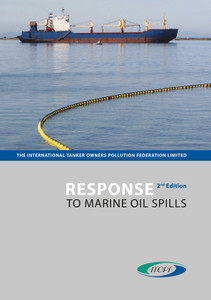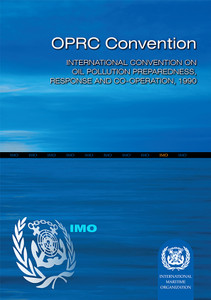
This manual provides guidance to Administrations and officials involved with oil pollution casualties so that they may effectively mitigate the effects of such accidents, particularly in relation to the salvage of vessels and cargo.
This manual addresses oil pollution problems rather than safety measures. It is a particularly useful guide for Governments of developing countries and for persons directly associated with the sea transportation and transfer of oil.
The manual is divided into six sections: Section III: Salvage (1997 edition) The Manual on Oil Pollution currently consists of four sections (sections V and VI are imminent), some of which have already been revised since they were first published.
Section III: Salvage was first published in 1983 and has now been extensively revised by the Marine Environment Protection Committee to extend its coverage to include substances other than oil. Section III of the Manual is intended to be used in conjunction with the national contingency plan that will have been prepared as described in the recently revised Section II: Contingency Planning. The guidance in Section III will help Administrations and officials involved with oil pollution casualties effectively to mitigate the effects of accidents, whether there is a spillage from a tanker or the release of bunkers from dry cargo vessels or passenger vessels.
This publication comprises section III of the Manual on Oil Pollution prepared by the Marine Environment Protection Committee of IMO.
The Manual on Oil Pollution consists of five sections:
Section I: Prevention (out of print; revision under consideration)
Section II: Contingency Planning (first published in 1978; revised edition published in 1995)
Section III: Salvage (first published in 1983; revised edition published in 1997)
Section IV: Combating Oil Spills (first published in 1988; currently under review)
Section V: Administrative Aspects of Oil Pollution Response (to be published in late 1997/early 1998)
The Manual on Chemical Pollution consists of two sections:
Section I: Problem Assessment and Response Arrangements (first published in 1987, currently under review)
Section II: Search and Recovery of Packaged Goods Lost at Sea (first published in 1991).
The Salvage section of the Manual on Oil Pollution has been extended to cover substances other than oil. The other above sections of the Manual which relate specifically to oil pollution will, later, be extended to cover substances other than oil.
The Marine Environment Protection Committee thanks the many experts who assisted in the preparation of the text and who contributed tables and diagrams, thereby making the publication of this section possible in its present form.
It is advisable that the national contingency plan (see section II of the Manual on Oil Pollution) contains information on where and how resources for the purpose of quick and effective salvage may be available.
This section of the Manual is intended to provide guidance to Administrations and officials involved with oil pollution casualties so that they may effectively mitigate the effects of such accidents, particularly in relation to the salvage of vessels and cargo. While most oil pollution casualties are likely to involve tankers, it should be noted that many dry cargo and passenger vessels have a bunker capacity of several thousand tons and may therefore pose a serious threat of oil pollution if involved in an accident.
1 – Introduction
1.1 General
1.2 Action by the ship-owner in the event of a casualty
1.3 Advice to masters
1.4 Position of the Administration
2 – Intervention
2.1 Powers under the 1969 Convention and 1973 Protocol
3 – United Nations Convention on the Law of the Sea
3.1 Article 221 – Measures to avoid pollution arising from maritime casualties
4 – International Convention on Salvage 1989
4.1 Application for the convention
4.2 Article 5(3) – Salvage operations controlled by public authorities
4.3 Article 6 – Salvage contracts
4.4 Article 8 – Duties of the salvor and of the owner and master
4.5 Article 9 – Rights of coastal States
4.6 Article 14 – Special compensation
5 – Advice to Administrations
5.1 Planning prior to a casualty
5.2 Customs and immigration facilitation
5.3 Communications
5.4 Establishment and maintenance of liaison with interested parties
5.5 Inventory of specialist salvage equipment
5.6 Provision of “harbours of refuge”
5.7 Maintenance of records
5.8 Action at the time of a casualty
5.9 Action subsequent to a casualty
6 – Salvage contracts
6.1 General
6.2 “No cure – no pay” and “service” contracts
6.3 Lloyds Standard Form of Salvage Agreement
Appendix 1 – Information on salvage methods, specialized salvage equipment and salvage techniques
Appendix 2 – Rate of drift for disabled tankers
Appendix 3 – Resistance to tow in still water conditions
Appendix 4 – Lloyds Standard Form of Salvage Agreement (LOF 1995)
A??s a specialized agency of the United Nations, IMO is the global standard-setting authority for the safety, security and environmental performance of international shipping. Its main role is to create a regulatory framework for the shipping industry that is fair and effective, universally adopted and universally implemented.
In other words, its role is to create a level playing-field so that ship operators cannot address their financial issues by simply cutting corners and compromising on safety, security and environmental performance. This approach also encourages innovation and efficiency.
Shipping is a truly international industry, and it can only operate effectively if the regulations and standards are themselves agreed, adopted and implemented on an international basis. And IMO is the forum at which this process takes place.
- Number of Pages:
- 44
- ISBN:
- 9789280114423
- Book Height:
- 250 mm
- Book Width:
- 210 mm
- Author:
IMO
- Preview:
- Yes
- Binding Format:
- Paperback
- Publication Date:
- January 1997





